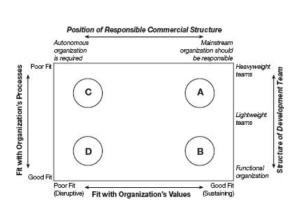“A surprising number of innovations fail not because of some fatal technological flaw or because the market isn’t ready, they fail because the responsibility to build these businesses is given to managers or organizations whose capabilities are not up to the task.” – Christensen & Raynor
In The Innovators Solution, Christensen and Raynor propose a method to define what organizations can and cannot accomplish – the RPV Framework. The RPV framework is composed of Resources, Processes, and Values.
Christensen and Raynor have developed a decision-making model, the purpose of which is to help managers determine the proper organizational structure and “home” for the new-growth business. Their model is below.
A Framework for Choosing Organizational Structure and Home
Axes
Fit with Organization’s Processes
The left vertical axis measures the extent to which the existing processes – the patterns of interaction, communication, coordination, and decision making current used in the organization – are the ones that will get the new job done effectively.
Fit with Organization’s Values
The lower horizontal axis asks managers to asses whether the organization’s values will allocate to the new initiative the resources it will need in order to become successful. If there is a poor fit, then the mainstream organization’s values will accord low priority to the project; that is, the project is potentially disruptive relative to its business model.
Position of Responsible Commercial Structure
The upper horizontal axis captures (on a continuum) the level of autonomy needed by an organizational unit attempting to exploit an innovation. For disruptive innovations, setting up an autonomous organization to develop and commercialize the venture will be absolutely essential to its success. At the other extreme, however if there is a strong sustaining fit, then the manager can expect that the energy and resources of the mainstream organization will coalesce behind it because the project is sustaining.
Structure of Development Team
The right vertical axis maps three types of organizational sturcutres that can be used to either exploit or overcome existing processes.
How to Use the Model
Overview
Using the model requires the manager to assess the organizations processes and values. Quite simply, the bottom and left sides of the model are used for “diagnosis”, the top and right sides of the model provide the “solution”.
First, evaluate the processes required to launch and scale the New Growth Business. If the New Growth Business requires new processes (poor fit), then it will require region A or C. If the New Growth Business can utilize existing processes (good fit), then it will require region B or D.
Next, evaluate the organizations values – according to Christensen and Raynor’s definition of values – and select the appropriate quadrant.
Region A
Region A depicts a situation in which a manager is faced with a breakthrough but sustaining technological change. It fits the organization’s values, but it presents the organization with different types of problems to solve and therefore requires new types of interaction and coordination among groups and individuals.
Region B
In region B, where the project fits the company’s processes as well as its values, the new venture can easily be developed by coordinating across functional boundaries within the existing organization.
Region C
Region C denotes a disruptive technological change that fits neither the organization’s existing processes nor its values. To ensure success in such instances, the managers should create an autonomous organization.
Region D
Region D typifies projects in which products or services similar to those in the mainstream need to be sold within a fundamentally lower-overhead business model. These ventures can leverage the main organization’s logistics management processes, but they need very different budgeting, management, and profit and loss profiles.
Caution
In using this model, it is important to remember that disruption is a relative term. What is disruptive to one company might have a sustaining impact on another.
Sources
* The Innovators Solution
